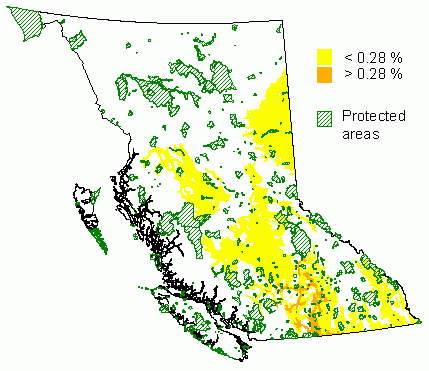 Choke cherry
Choke cherry
Prunus virginiana L.
Introduction
Choke cherry grows as a shrub or small tree, ranging in height from 1 to 6 m. It may grow in dense thickets, mixed with other shrubs, in sparse stands, or under open forest canopies. Choke cherry occurs in many types of habitat and plant associations. It is shade tolerant and can invade new sites as well as maintain a presence in climax associations. It grows at low to mid-elevations, in moist but well-drained, acid to moderately alkaline soils. Choke cherries are an important food for wildlife and are also edible for humans. Choke cherry plants are used as ornamentals, in windbreaks, and for watershed protection (Johnson 2000). The species is susceptible to many pests and diseases. Of these, a fungus (Plowrightia stansburiana) resulting in knot-like cankers on the stems is important because it eventually kills infected stems (Lanner 1983). Choke cherry has some potential as a future native horticultural crop (St. Pierre 1992).
Choke cherry is widely distributed throughout southern Canada and much of the United States (Little 1976; Little 1977). There are three varieties, two of which grow in British Columbia (Hitchcock and Cronquist 1964). Western chokecherry (var. demissa (Nutt.) Torr.) occurs from British Columbia southward into northern Mexico. Black choke-cherry (var. melanocarpa (A. Nels.) Sarg.) occurs in southern Canada from eastern British Columbia to Alberta; southward throughout the Rocky Mountains to New Mexico; and in the Pacific region to northern California.
Distribution and Protected Areas – from Hamann et.al. 2005



Conservation Status Summary – from Chourmouzis et.al. 2009
“Choke cherry is generally adequately protected in the BWBS, SBS, IDF, and BG zones, where it occurs most frequently. In the Rocky Mountain Trench, protection is sufficient in the higher-elevation MS zone but not in the PP or IDF zones. Ground truthing in the PP and ICH zones is recommended.”
Reproduction
Choke cherry reproduces both sexually and vegetatively. Fruit crops occur annually (Banerjee et al. 2001) and seeds are usually viable (Monsen and McArthur 1985). Large numbers of choke cherry seeds are deposited right under the parent plants, where they may remain viable for a long time in a seedbank (Kramer 1984). Long-distance seed dispersal also occurs via birds and mammals (White and Stiles 1992).
Genetic structure
No information available.
Resource management and seed transfer
No information available.
REFERENCES
Hamann, A., Smets, P., Aitken, S. N. and Yanchuk, A. D. 2005. An ecogeographic framework for in situ conservation of forest trees in British Columbia. Can. J. For. Res. 35:2553-2561. View online resources for this report.
C. Chourmouzis, A.D. Yanchuk, A. Hamann, P. Smets, and S.N. Aitken. 2009. Forest Tree Genetic Conservation Status Report 1: In situ conservation status of all indigenous BC species. Centre for Forest Conservation Genetics, Forest Genetics Council of BC, and BC Ministry of Forests and Range, Forest Science Program, Victoria, BC Technical Report 053. www.for.gov.bc.ca/hfd/pubs/Docs/Tr/Tr053.htm
Banerjee, S. M., Creasy, K. and Gertzen, D. D. 2001. Native woody plant seed collection guide for British Columbia. Crown Publications, Victoria. 147 p.
Hitchcock, C. L. and Cronquist, A. 1964. Vascular plants of the Pacific Northwest. Part 2: Salicaceae to Saxifragaceae. University of Washington Press, Seattle, WA. 597 p.
Johnson, K. A. 2000. Prunus virginiana. U.S. Department of Agriculture, Forest Service, Rocky Mountain Research Station, Fire Sciences Laboratory (2002, January). Fire Effects Information System. [Online]. Available: http://www.fs.fed.us/database/feis/ [January 2002].
Kramer, N. B. and Johnson F. D. 1987. Mature forest seed banks on three habitat types in central Idaho. Canadian Journal of Botany 65:1961-1966.
Lanner, R. M. 1983. Trees of the Great Basin: A natural history. University of Nevada Press, Reno, NV. 215 p.
Little, E. L., Jr. 1976. Atlas of United States trees, volume 3, minor western hardwoods. U.S. Department of Agriculture Miscellaneous Publication 1314. 13 p., 290 maps.
Little, E. L., Jr. 1977. Atlas of United States trees, volume 4, minor eastern hardwoods. U.S. Department of Agriculture Miscellaneous Publication 1342. 17 p., 230 maps.
Monsen, S. B. and McArthur, E. D. 1985. Factors influencing establishment of seeded broadleaf herbs and shrubs following fire. p. 112-124 in: K. Sanders and J. Durham, (Eds.), Rangeland fire effects. Proceedings of the symposium, November 27-29, 1984; Boise, ID.
St. Pierre, R. G. 1992. The development of native fruit species as horticultural crops in Saskatchewan. Hortscience 27:866-947.
White, D. W. and Stiles, E. W. 1992. Bird dispersal of fruits of species introduced into eastern North America. Canadian Journal of Botany 70:1689-1696.
